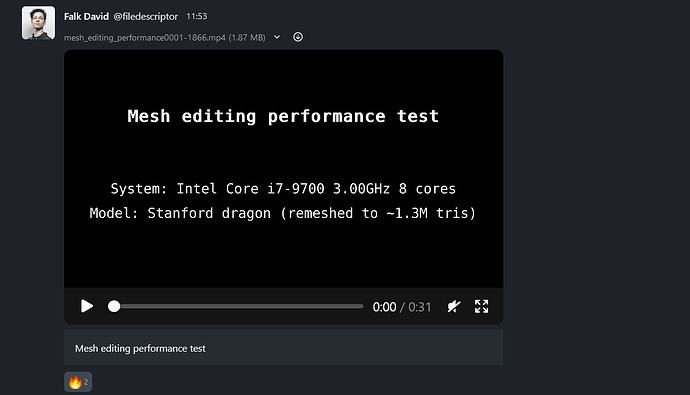The scoffers who were skeptical of serious performance boosts for the next release may have pie in their face now. A couple of the benchmarks will soon be over 20 times the speed of Blender 2.8 (and don’t forget the big OpenSubDiv performance boosts coming in from Kevin).
This looks very promising so far but I really hope this means edit mode speed ups across the board including proportional editing, sculpting and whatnot - not just here and there for certain modifiers or modelling functions/modes.
Expectation were low because target was to “bring 2.7x speed”, whose performance was em… not amazing. And there were no such performance sprint before.
According to tomjk’s test we are now at 1.5x 2.79 speed with up to almost 4x in some cases.
And there are still a lot of bottlenecks, but i’m glad that there are finally nice editing performance improvements.
Sculpting is a different system but there are some patches.
In my tests proportional editing also gets a significant boost - PE’s performance was indeed hobbled by the slow mesh processing rather than anything else.
In my tests even 2.93 is already over 4 times faster than v2.79. I am unsure what kind of test files he is using, but I am basing this on a “real world” scene (the Wright Flyer which can be download in an earlier post of mine here). v2.79 is horribly slow compared to even 2.93. Much slower than the purported 1.5x comparison with 3.0 alpha!
The same result when I work with the dragon model: v2.79 runs as slow as a slug in molasses in edit mode. Again, even 2.93 is much faster to edit with.
I do not understand the discrepancy between my testing and Tomjk. I test the same Dragon mesh, and in my case the speedup factor is far greater than their measurements.
2.79 is just really, really slow to edit with in edit mode. Already at least 4 times slower than 2.93, and the latest build (before the patches mentioned just earlier) is again about 3 times faster than 2.93.
An improvement of around at least a factor of 12. Hardly the 1.5 times @tomjk reports.
Entering Edit mode is also twice or thrice as fast in v3 alpha on my system - which his figures indicate is identical in 2.79 vs v3 alpha.
So what gives? Am I missing a setting in 2.79 that causes it to perform that bad in openGL on my system? I also compared LightWave Modeler, and as expected Modeler performs worse than v.2.79 - which in my book means 2.79’s mesh editing mode is indeed operating at the expected pace (Modeler was always slower than 2.79).
I just tried downloading it but it just says folder empty. Am I missing something or is the flyer file gone?
Do you see that in 2.93.1 official or is it some later build you are using for your tests?
Maybe the performance difference comes down to the hardware/software used:
his tests are on:
- linux mint
- i7-6700k
- RTX 2060 Super
yours are on:
- windows
- R9 3900X
- GTX 1080
I guess there might be some tweaks here and there in these patches that favor one config over another (like most of the multi-threading specific patches that will favor your 12 cores vs his 4 cores CPU), if you add things like different OS and other stuff, it should be clear why the results are different even when using the same reference model.
I am using the official release of 2.93.
Ah! That explains it perhaps - the OS! No, the video card wouldn’t cause such discrepancies. I had similar performance differences on Windows and other apps while working with weaker GPUs.
But that OS - yes, that explains it, probably. Which means I should probably test on Linux too. I was planning to install a dual-boot Linux/Windows system in the upcoming month anyway.
Good catch - did not notice that.
Still, feels like a huge difference in 2.79 performance if this is the cause. As you say, multi-threading may play an important role as well.
the core count is probably the biggest impact
Updated previous post with test data from latest improvements in master (particularly this one).
This one’s an ever so slightly mixed bag, but there are a few big gains and what losses there are compared to the last tested version are in statistical noise territory. And of course, as laid out above, mileage will vary ![]()
edit: not sure how to account for the loss in the do-nothing tests #25/26, though.
edit 2: actually I just tried those two tests again just now and the results were better for a time, then dipped again. I’m inclined to just remove them in future revisions because I’ve not got a lot of confidence in their accuracy.
I didn’t expected Rotate didn’t get any improvements at all even when all verts are selected.
I don’t think it’s noise. I mean, statistcally it can be, but 4 instances of no change in performance whatsoever versus 14 instances of slight performance drop is sus.
I think it’s like third commit for this project from Campbell that went completely out of nowhere without any review. Not that I against it, I like surprises. ![]()
On a side note, this project was planned to be 6-8 weeks long. Lower bound of that range will be reached next week but I don’t expect it to end that way. But there are currently only 3 patches that are not committed (or abandoned) so we might not reach upper bound either.
And one of the remaining patches looks like it will bring the biggest editmode boost in the entire sprint (when looking at the benchmarks). That means it is possible the optimization effort will end with a bang relatively speaking (so even if those patches are the last, editmode in version 3 will officially be much faster than in version 2.79). Things will still not be as fast as 3DS Max, but Blender should place well.
All hands on deck for the other side of the coin (OpenSubDiv optimizations), I hope.
Mesh editing performance test
This screen capture is taken from https://blender.chat/channel/modeling-module
the test includes the latest 3.0 alpha + the [D11599 patch] (https://developer.blender.org/D11599) mentioned in this thread before vs 2.93
Why did they use remeshed version? The original model has 7.2 mil tris. People assume the video is made with original model.
The Stanford Dragon has 871.414 polygons, in its Vrip reconstructed form.
Can someone do this test in Blender 3.0 my potato laptop specs to low to try, would like to see if it is better.
Right. That’s smaller one. There are two Stanford dragons. All dragons looks same.
But, still why not using the original model?
As the video showed, editing the model was barely doable in 2.93, version 3 with the upcoming depsgraph patch is downright smooth in comparison.
We need to be realistic, the amount of work needed to allow (close to) 60 FPS editing of 7.2 million polygons in editmode is higher than what can be done in 2 months (which might require some major rewrite work on the modeling core). If the devs. find a way to prove me wrong I would consider it a welcome correction.
Realistically, the only practical way to work with that amount of polygons is through the use of sculpt mode (because the nature of it allows it to be far faster and more intuitive for such densities, especially once the reworked core is committed).


